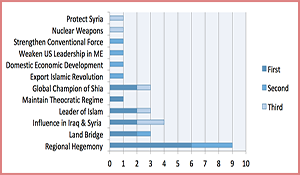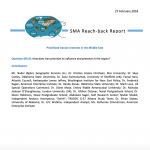Prioritized Iranian Interests in the Middle East

Question (R6.9): How does Iran prioritize its influence and presence in the region?
Author | Editor: Canna, S. (NSI, Inc).
Executive Summary
Hoping to answer the question of how Iran prioritizes its influence and presence in the Middle East, we asked fifteen experts to list—in rank order—Iran’s key interests, how it seeks to realize those interests, and how successful it is likely to be in the next 18-24 months.1 As is evident in Figure 1, a clear majority of experts consulted identified regional hegemony as Iran’s primary regional goal.2 However, while listed only once as a top three interest, Dr. Nicholas O’Shaughnessy of the University of London argues that the primary objective of the Iranian government is the continuity of the theocracy in power in Iran. “Everything else flows from this,” he writes. Indeed, many of the other interests listed in Figure 1 could be construed as mechanisms for establishing and expanding Iran’s desire for regional hegemony and, more importantly (and implicitly), regime continuity.
Appendix A briefly describes the interests listed in Figure 1. The task of identifying and grouping interests from the expert contributions was complicated because 1) many of the interests are interrelated, 2) some are policies or tactics that are the means to achieving higher objectives, and 3) some are at different levels of generality. However, the interests listed do tend to cluster around four key areas—Islamic identity, national security, regime security/continuity, and domestic support. Iran’s interests and how they choose to prioritize and implement them is a complex system perhaps best represented by a loop diagram, see Figure 2.
Once you have interests mapped into a looped diagram—representing Iranian interests as a complex system—it is possible to dive more deeply into the related factors driving, hindering, and complicating a particular interest or tactic. For example, based on the high-level information provided by experts in their contributions, Figure 3 shows how Iran’s pursuit of regional hegemony is linked to other factors, tactics, and policies. This visualization is an example of how Iran’s interests might best be displayed in a diagram. We did not ask the experts to explicitly support this kind of visualization, so it is primarily a notional representation. The SMA team in conjunction with the experts could complete the loop diagram as part of a future reach back effort.
Land Bridge
The Iranian idea of creating a land bridge to Lebanon through Iraq and Syria is closely linked with Iran’s goal of reducing US influence in the region (Ostovar). Maintaining this block of allies is crucial not only for reducing US influence and maintaining deterrence leverage against Israel but for denying Saudi Arabia a platform to expand its influence among Sunni populations, particularly in Iraq (Biglari, Ostovar). However, Dr. Zana Gulmohamad of Sheffield University would caution that Iran is not rigid in only working with Shia groups. He writes, “Iran does not necessarily look for actors that are similar (Islamic Shia) or have the same sectarian visions or doctrines as this would ease and facilitate its hegemony (Gulmohamad). Rather, it aims to expand its power and influence with other actors that have similar interests, which would bolster its influence in the region. Therefore, it is willing to cut deals with any external power that serve its interests, but Iran’s interests also serve its religious doctrines as well as the elites in Tehran.”
Influence in Iraq and Syria
Closely related, Dr. Ostovar contends that Iran tends to view the region in black and white terms, making long-term US presence and influence untenable to the Iranian government. However, Mr. Biglari notes that Iran has “no qualms coordinating and cooperating with the US and US-back forces when and where it advances their purposes.”
Leader of Islam
Mr. Mubin Shaikh, a regional expert, argues “Iran sees itself as the cultural superior to the Arabs, which they believe are wrongly seen as automatic inheritors of the Islamic tradition.” To reinforce its leadership role in the Islamic world Iran has successfully used Shia militias (Watkins) to defend both Sunni and Shia religious sites in Iraq and Syria (Luce). Not to do so “would force Iran to forfeit any claims to leadership of the entire Muslim umma.”
Global Champion of Shia
AMB Jeffrey observes that Iran sees itself as both a state and cause: it is a nation-state with sovereignty and obligations to the people it governs, but it is also a defender of Shia everywhere. This is seen as their destiny, which brings Iran into direct conflict with Sunni traditions—particularly Wahhabism— seeking the same path. Therefore, the best way to deter attacks against Shia is to develop and project Iran’s hard power image primarily by expanding Iran’s military, para-military, and defense forces, Dr. Mark Luce states.
Export the Islamic Revolution
It is not enough to be the defender of Shia Islam; the Iranian government seeks to export its particular form of theocratic governance known as Waliyat-al-Faqih (Gulmohamad). In this interpretation of Islamic jurisprudence, Iranian leadership has a duty to bring its form of government to Shia populations, particularly those in nearby Iraq and Syria. They do this through soft power: by protecting Shia religious sites, providing resources and services to the impoverished, refurbishing mosques, and appealing to emotion, tradition, and shared experience, Dr. Diane Maye of Embry Riddle Aeronautical University notes.
Domestic Economic
Going back to the point made in the first paragraph, first and foremost, the Iranian leadership seeks to maintain its form of governance and stability in Iran (O’Shaughnessy). After years of economic sanctions, reviving the domestic economy is a pressing concern, Dr. Luce argues. The economic challenges facing Iran are made even worse by projections suggesting zero population growth by 2036.
Weaken US Leadership in Middle East
Similar to the objectives of Expanding Influence in the Iraq and Syria and Creating a Land Bridge to Lebanon, Iran would like to weaken, but not eradicate, US and Coalition presence and influence in the Middle East, according to Dr. Skye Cooley and his team. The US and Coalition forces create a stabilizing force in the region that paradoxically allows Iran to increase its influence in the Iraqi government while at the same time casting doubt on the US as a stable, long-term partner in the Middle East.
Strengthen Conventional Forces
Dr. Frederick Kagan and Ms. Katherine Zimmerman of the American Enterprise Institute suggest that Iran is using its efforts to uphold the Assad regime to develop and test conventional force capabilities as well as improve joint operations and command and control efforts. Developing a strong conventional capability acts as a deterrent as well as serves its interest in establishing regional hegemony.
Develop Nuclear Weapons
Dr. Maye believes that Iran continues to desire the development of nuclear weapons, nuclear power, and the ability to enrich uranium. This goal is interesting because it speaks to ambitions on the international stage as well as on the domestic or regional front. Developing even a latent capability provides diplomatic gravitas and strengthens its bargaining position against stronger governments and institutions.
Protect Syria
Dr. Kagan and Ms. Zimmerman write about Iran’s existential interest in protecting its long-standing ally in Syria. It is likely to continue to provide diplomatic support for the Assad regime and pursue favorable political resolution through the Astana talks. A favorable political resolution is one in which Iran may sustain deployments of IRGC, Shia militias, Hezbollah, and other proxy forces in the region as well as minimizing US presence and influence in the country.
Conclusion
By and large, our experts conclude that Iran is likely to continuously and incrementally increase its role and influence in the Middle East. Dr. Luce warns that “[a]bsent a serious effort (e.g. equivalent to JCPOA, Iraq Surge, post-Nov ’15 ops against ISIS level) the U.S. will fail” to halt the spread of Iranian influence and power in the region. He suggests that instead of playing into the sectarian tensions in the region—and attempting to balance or influence which side wields the most influence—the USG should have as its motive “the preservation of a rules-based security order in the turbulent Middle East.”
Contributors
Mr. Nader Biglari, Geographic Services Inc.; Dr. Kristian Coates Ulrichsen, Rice University; Dr. Skye Cooley, Oklahoma State University; Dr. Zana Gulmohamad, University of Sheffield (UK); Faysal Itani, Atlantic Council; Ambassador James Jeffrey, Washington Institute for Near East Policy; Dr. Frederick Kagan, American Enterprise Institute; Dr. Randy Kluver, Oklahoma State University; Dr. Mark Luce, US Special Operations Command; Dr. Diane Maye, Embry Riddle Aeronautical University; Dr. Nicholas Jackson O’Shaughnessy, London University (UK); Dr. Afshon Ostovar, Naval Postgraduate School; Dr. Glenn Robinson, Naval Postgraduate School; Abdulaziz Sager, Gulf Research Center; Mubin Shaikh, Independent Analyst; Anonymous “Smith”; TRADOC G-27 Athena Study Team; Dr. Ethan Stokes, University of Alabama; Dr. Eric Watkins, Independent Analyst; Ms. Katherine Zimmerman, American Enterprise Institute

Comments